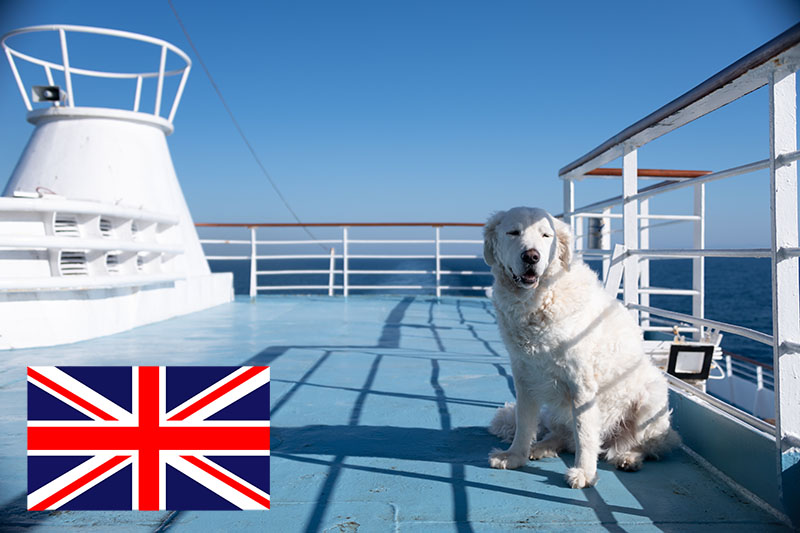Can your dog come with you on holiday when you take the ferry?
The rules of the ferry companies surrounding traveling with pets and dogs are different for every ferry company. While the official rules in the UK for instance are rather strict[1]Official rules: Travelling with a cat or dog the rules on the ferries are a bit less strict. However, this is different per ferry company.
In the following article, we talk about everything related to dogs and pets on ferries.
- Are you allowed to bring your dog on the ferry?;
- What conditions do you have to meet?;
- Which ferry company is allowed or not allowed;
- How to envision the journey, the dog on board (kennel, dog deck)?;
- What about the dog passport?;
- What vaccinations are required, for example?
- The rules can also differ per country;
- And the costs can also differ per company.
Are dogs and pets allowed on the ferry?
This is the first question to be answered, in many cases, the answer is yes, however subject to various conditions. Many of the ferry companies have a limited number of pet-friendly cabins and, for example, a specially designated place for dogs on the ferry.
At many of the ferry companies, you can find information about whether the dog can come with you. At DFDS, for example, you have pet-friendly cabins, these can only be reserved by telephone. [2]Pet Friendly cabins, DFDS.com.
In many cases, the dogs do not have access to public areas on ferries, but there is, for example, a specifically designated area or deck where the dog can come and be walked.
When you travel with your dog, also consider until it often goes up to a maximum of 2 dogs per cabin.
Contact your vet well in advance – at least 4 months – to discuss which conditions your dog must meet to be allowed on a trip, also because this can differ per destination. Or take a look at your local government website what import requirements are needed.
The breed of your dog can also be important. In many countries, for example, pit bulls are not allowed. In France, among others, crosses of Staffordshire terriers, mastiffs Boerboels, tosa, and rottweilers are also not welcome, and in Norway, the same rules apply to dog breeds as for France. Not all dogs are allowed in the UK either. The banned dogs for the UK you find on this list: Banned dogs in the UK are here.
Conditions for traveling with your dog or pet per boat
The dogs or other pets must:
- Have a valid (European) pet passport when traveling internationally.
- Are chipped: if you want to take your dog or pet with you, it must be chipped and recorded in travel documents [3]Traveling with pets, DFDS.com, for example, the pet passport.
- Have been vaccinated: in any case, have been vaccinated against rabies (rabies) with evidence. Conditions for vaccinations can differ per country, but also keep in mind that the vaccination often has to take effect and you are not allowed to travel with your pet yet.
- Common (not always) for dogs: a tapeworm treatment before the dog goes on a trip to another country. This too must often be recorded in the passport.
- Breed of the dog: The breed of the dog can be important to the destination country. In many countries, for example, pit bulls are not welcome. You can read more about this on national government websites.
- Liability insurance: in many European countries it is mandatory to have this.

Which ferry companies allow you to bring your dog on board?
Provided that your dog meets the basic requirements such as having a dog passport, and is chipped and vaccinated your dog may be taken on board, among other things, on crossings of, among others, the ferry companies below, with attached also the specific information pages about traveling with dogs
Your dog is welcome under certain conditions at:
- Brittany Ferries Dogs – Real pet-friendly, though some extra requirements other ferry companies do not have concerning extra toys and ‘nappy sacks' for dogs. Read more about it here.
- Irish Ferries dogs – Also Kennel facilities on each ship! The kennels can be booked in advance and are free of charge. Read more about Irish Ferries and pet travel.
- DFDS Dogs – At DFDS Dogs are welcome, while funny enough birds are not. More info about dogs at DFDS travel can be found here:
- Stena Line – at Stena Line you can find information about traveling with dogs on this page. Stena Line sails to Hook of Holland – Harwich, Frederikshavn – Gothenburg, and Kiel – Gothenburg, among others. Beware of the rules regarding vaccinations and passports with Stena Line.
- P&O Ferries Dogs – At P&O Ferries you can find the pet rules here. The cost to bring a pet is different per route however the average price with P&O is around € 20,-.
- Holland Norway Lines – HNL operates the route between Eemshaven and Kristiansand. At HNL you can also take your dog on board. More information about this can be found in the FAQ from HNL.
- MobyLines Dogs – animals are also welcome at MobyLines – the information from Moby Lines can be found here. At Moby Lines, You can take up to 3 pets in your cabin instead of the regular 2 pets per cabin policy for other ferries.
- Finnlines Dog Policy – At Finnlines there is even a tree stump on the designated walking and walking deck!
- Color Line Dogs – With Color Line, the dog must remain in the car or the cage on the car during the entire crossing. Preferably make a reservation by phone. We would advise against this for longer crossings as the dog is not allowed to leave the cage or car. You can read more about it here. (Price starts at € 12)
- Fjord line – Dogs can also come along at Fjordline. For €13 you have a dog kennel and small dogs are allowed in the car for €7. There are also special cabins on board the MS Stavangerfjord and the MS Bergensfjord where dogs are allowed. More about traveling with dogs at Fjordline can also be read here.
- Armas – At Armas, it seems to be a bit more strict and expensive to bring dogs along: Your pet must board the ferry in a transport box if their size and weight allow. Otherwise, they must wear a muzzle and be kept on a leash at all times when boarding the ferry. A maximum of 2 pets per cabin are permitted.
- Tallink Silja lines have special pet cabins and/or kennels on board. (€16,- per pet between Finland and Sweden. €13,- between Sweden and the Baltic States, night crossings €26,- maximum 3 pets per crossing). On the Baltic Princess, even a sandbox for the pets.
There are specific rules for service dogs – in almost all cases, service dogs are welcome everywhere. You also do not have to pay for bringing your assistance dog.
How does it work? Kennel? Pet-friendly cabins? Dog deck?
For shorter crossings it is often a matter of keeping the dog with you during the crossing, for example at Calais and Dover there is a special area in both ports for pets to stretch their paws.
On short crossings, the dog is generally expected to remain in the car or with the owner in the specially designated pet lounges.
For these short, cabin-less crossings, make sure the dog has eaten well in advance; in connection with seasickness and took a pee shortly before.
For the longer crossings, for example with a night crossing, there are often animal-friendly huts available. There is also a specifically designated dog deck where the dog can be walked. In many cases, dogs are only welcome in these specifically designated areas and animal-friendly huts.
To reserve animal-friendly cabins, it is often the most convenient to contact the shipping company you have in mind for the crossing by telephone. In some cases, you can only book by phone.
Dog passport for travel
Are you going on holiday or traveling and do you want to take the dog with you? Then you need an animal passport within and outside the EU. Don't have a dog passport yet? You can request this from an official veterinarian.
If you want to travel through Europe with your dog, you also need a chip for identification in addition to the European pet passport. Most dogs are microchipped and registered within 7 weeks of birth, double check before departure. The dog can be chipped at the vet
Vaccinations and treatments for travel
Then the mandatory vaccinations and treatments: if you travel with your dog, it must be vaccinated against rabies. The vaccination must be completed no later than 21 days before departure. Dogs must also be treated against the fox tapeworm in many cases.
Is the dog younger than 12 weeks? Then they are too young to be vaccinated against rabies and are therefore not allowed to travel yet.
Dog rules per country
The rules for bringing your dog may vary slightly from country to country. Broadly speaking, there are 4 things to think about:
- Dog Passport,
- Being microchipped,
- Being vaccinated,
- Tapeworm treatment.
In some countries, there are restrictions on specific breeds and crosses. These exceptions can be found clearly per country in this extensive list of import requirements in Europe per country.
Price of Bringing Dogs on a ferry
Finally, we have to talk about the costs that you pay for bringing Fikkie on board. In some cases, you pay an extra fee for booking a pet-friendly cabin, and often you also pay a ticket for the dog, except for assistance dogs.
In the table below you will find an overview of the costs per dog for a one-way ticket.
| Maatschappij | Overtocht | Kosten hond |
|---|---|---|
| Color Line | All Transfers | €12 (in car) €18 (in kennel) |
| Corsica Ferries | All Transfers | €17 |
| DFDS | Calais - Dover | €18 |
| DFDS | Duinkerken - Dover | €18 |
| DFDS | Amsterdam - Newcastle | €32 |
| Fjordline | Hirtshals - Norway Routes | €7 (in car) - €13 (in kennel) |
| HNL | Eemshaven - Kristiansand | €30 |
| Mobylines | All Transfers | €15 |
| P&O Ferries | Calais - Dover | €15 |
| P&O Ferries | Rotterdam - Hull | €26 |
| Stena Line | Hook of Holland - Harwich | €18 |
| Tallink Silja | Helsinki - Talinn | €13 - €26 (night time transfer) |
| Tallink Silja | Stockholm - Tallin & Stockholm - Riga | €16 |
| Brittany Ferries | To France | €18 |
| Irish Ferries | All Routes | € 30 / € 45 / €60 (Kennel) |
Things to know!
- The animal-friendly cabins often have a vinyl floor or carpet to make it pleasant for your dog.
- If you want to travel by ferry and seek a motorhome that is dog-friendly for the crossing you can rent one of these dog-friendly motorhomes here.
- On some ferries, there are even tree stumps that the dogs can use.
- Most ferries are a bit more relaxed on the ferry traveling in reality than within the strict rules on the websites. (However, you can't count on this)
Tips and experiences?
Do you have any tips for traveling with your dog by ferry? Then we are very curious. We are also curious about the experiences of our visitors about how they liked traveling by ferry with the dog. We would certainly appreciate it if you would like to share your experience in our comments!
References
| ↑1 | Official rules: Travelling with a cat or dog |
|---|---|
| ↑2 | Pet Friendly cabins, DFDS.com |
| ↑3 | Traveling with pets, DFDS.com |
| ↑4 | Bringing your pet dog to Great Britain, Gov. UK |











I do not see Condor Ferries mentioned in the information.
This article provides a comprehensive guide on traveling with dogs on ferries. It emphasizes that the rules vary among ferry companies, making it essential to check the specific regulations for each company. While some ferry companies have strict rules regarding pets, many do allow dogs on board, albeit subject to certain conditions. Some ferries have pet-friendly cabins, while others have designated areas or decks for dogs. It is important to contact the vet well in advance to understand the requirements and vaccinations needed for the trip, as they may differ depending on the destination. Breed restrictions also exist in certain countries, such as the UK, France, and Norway. Overall, this article serves as a valuable resource for dog owners planning to travel by ferry.
Thanks ‘Dog Kennels in Auckland’ =)
Would be awesome if you would link from your site towards this article that you describe as ‘the most comprehensive guide on traveling with dogs on ferries.” ! Much appreciated and we are happy that the guide was able to help you.